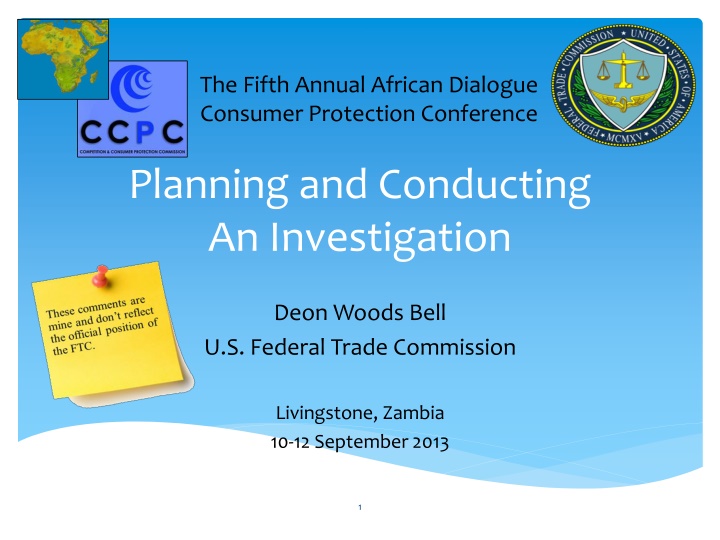
Guidelines for Effective Investigation Planning in Consumer Protection
"Learn about the essential steps and elements involved in planning and conducting investigations in the field of consumer protection. This comprehensive guide covers developing theories, collecting evidence, creating investigation plans, and understanding legal aspects. Discover the benefits of having a structured investigation plan and how it can streamline the process. Explore the importance of identifying legal theories, evidence sources, and tasks in ensuring a thorough investigation to safeguard consumer rights."
Download Presentation

Please find below an Image/Link to download the presentation.
The content on the website is provided AS IS for your information and personal use only. It may not be sold, licensed, or shared on other websites without obtaining consent from the author. If you encounter any issues during the download, it is possible that the publisher has removed the file from their server.
You are allowed to download the files provided on this website for personal or commercial use, subject to the condition that they are used lawfully. All files are the property of their respective owners.
The content on the website is provided AS IS for your information and personal use only. It may not be sold, licensed, or shared on other websites without obtaining consent from the author.
E N D
Presentation Transcript
photo Title 2 The Fifth Annual African Dialogue Consumer Protection Conference Planning and Conducting An Investigation Deon Woods Bell U.S. Federal Trade Commission Livingstone, Zambia 10-12 September 2013 1
photo Title 2 A complaint arrives on your desk What do you do now? 2
photo Title 2 Steps in Conducting an Investigation 1. Develop a theory of the case 2. Identify sources of information 3. Interview witnesses 4. Requests documents and data 5. Organize and assess the evidence 6. Determine whether there is a violation of the law 3
photo Title 2 What is an Investigation Plan? A plan that outlines the various parts of the investigation No set format, but usually a detailed outline or narrative document that is updated as the investigation proceeds 4
photo Title 2 Includes 3 Primary Areas Legal theories identifying the laws that may have been violated Evidence identifying sources of evidence and pertinent facts to help evaluate the law violations Tasks specifying investigation tasks and assignments and identifying the time and personnel required 5
photo Title 2 Benefits of an Investigation Plan Provides an organized roadmap for staff to follow in developing a case and presenting it to the decision makers Allows managers to better understand and oversee the investigation Provides continuity when adding and removing staff members from investigation team and efficiency 6
Elements of an Investigation Plan - Legal Theories - photo Title 2 Theory of the case a short summary of the conduct being investigated and how it might violate the law Theory of harm highlights the harm consumers have suffered as a result of the trader s conduct Defenses and arguments against the case Consider potential defenses that the target of the investigation may make and what evidence may support the trader s case Remedies what remedy will address the harm, what information is needed to determine the appropriate remedy, and what evidence is required to support the remedy? 7
Elements of an Investigation Plan - Evidence- photo Title 2 Elements of the offense Evidence What information is needed to satisfy the legal elements, and what might suggest that the case should be closed? Where can the information be found? (documents, witnesses, etc.) How can it be obtained? (voluntary versus compulsory) Evidentiary standards What are the evidentiary standards required by the decision maker? Will the information gathered satisfy those evidentiary standards? 8
photo Title 2 Evidence Matrix Elements Evidence Obtained Evidence Needed Source of Evidence Evidence Gathering (how to obtain, by whom, when) 9
Elements of an Investigation Plan - Tasks - photo Title 2 Timing and Administrative Tasks Identify specific tasks, assign responsibilities and set deadlines Resource Considerations Staffing Office resources Expert requirements and costs Legal requirements and costs Travel requirements and costs Timing requirements and any internal or external deadlines Communications 10
Investigation Agenda (non-exhaustive, work in progress) photo Title 2 TASK ACTION RESPONSIBILITY TARGET DATE STATUS 1. Administrative Tasks 2. Interviews Dave Jan. 8 Done Prepare list of interviewees Prepare questionnaires Melissa Jan. 9 Done Conduct interviews Team Jan. 30 Done Ongoing Follow-up with in-person mtg Review/summarize info Team 3. Written Evidence Voluntary information Follow-up with merging parties Compulsory information Prepare orders Issue orders Receive responses Input in litigation support database 11
photo Title 2 Coordination with Others Criminal Authorities Foreign Agencies Cooperating with other CPAs Consulting with international networks Foreign Criminal Cooperation 12
The Investigative Plan Using the Investigational Plan photo Title 2 1. Roadmap for the staff Focuses on important/priority issues Organizes the investigation and evidence Living document evolves as the case develops Framework for preparing recommendation document for decision makers Allows colleagues to provide feedback 2. Oversight of the investigation Allows investigation to be effectively supervised and reviewed Right issues identified, investigated and discussed Resources not wasted on superfluous issues Reasoned decision can be made to close or go forward Aids in staffing and other budgetary decisions 13
The Investigative Plan Using the Investigational Plan photo Title 2 3. Helps present the case to the decision maker Organizational tool Facts not just dumped Explains the law, facts, and economics Identifies the strengths and weaknesses of the case; good and bad witnesses; good and bad facts Allows colleagues to provide feedback Risks of going forward 14
photo Title 2 Sequencing for Gathering Information Complainant Develop a Theory Analyze the Evidence Identify Sources Documents Interviews Target Request Documents Interview Witnesses 15
photo Title 2 Thank you! Questions? For all questions, please contact Deon Woods Bell dwoodsbell@ftc.gov +1-202-326-3307 16
